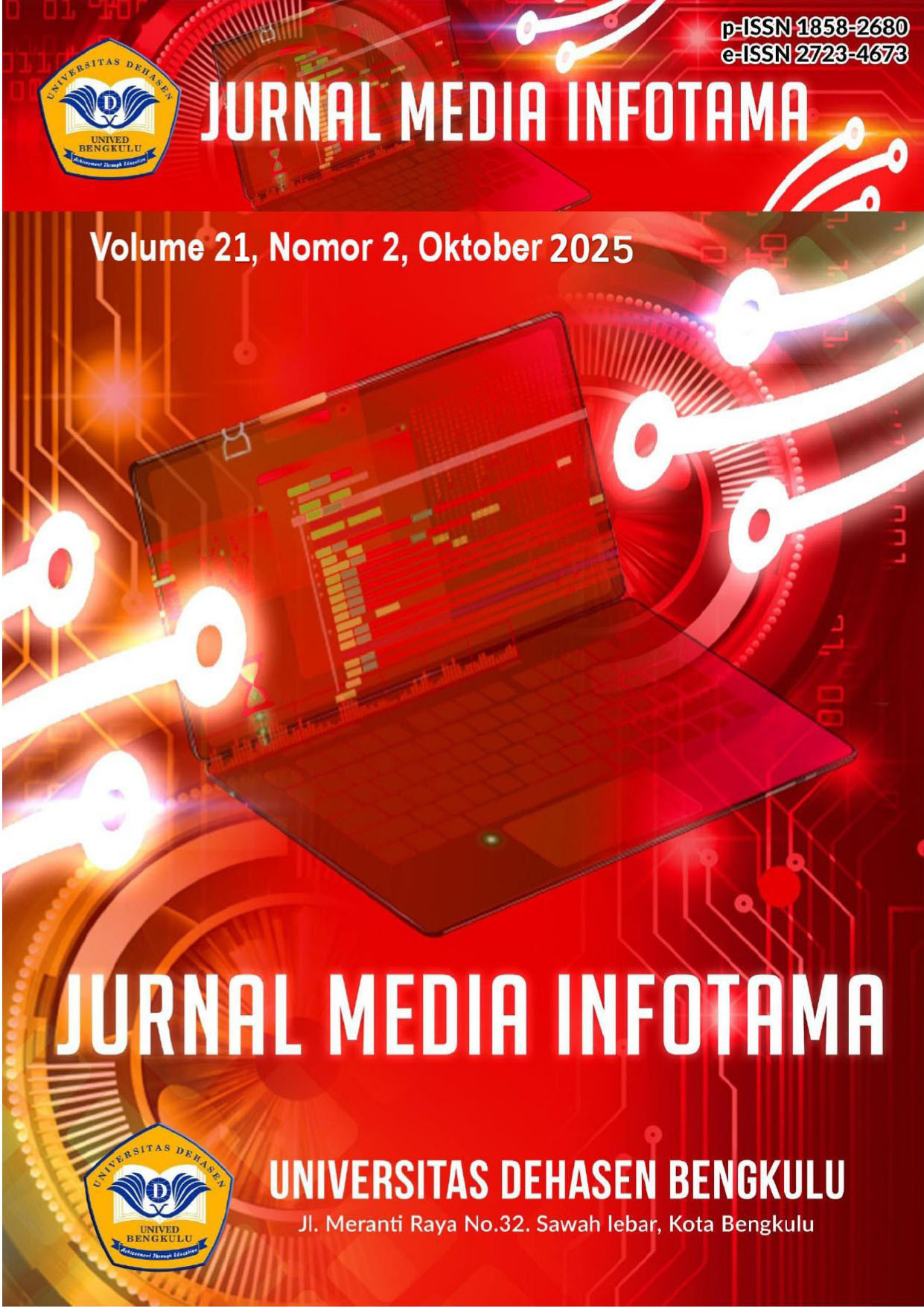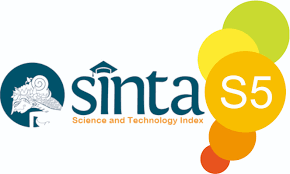Sistem Pemesanan Berbasis Web Pada Usaha Bouquetqu.AD Menggunakan PhP Dan MySQL
Abstract
Advances in information technology have encouraged micro, small, and medium enterprises (MSMEs) to adapt through the digitization of business processes, including ordering systems. The research aims to design and implement a web-based ordering system for Bouquetqu.ad—a creative business in Bengkulu City specializing in the sale of gift bouquets. The system was developed to address the limitations of the manual ordering system previously used, which had resulted in low efficiency and limited marketing reach. The system development method used is Waterfall Model, with stages including needs analysis, system design, implementation, testing, and maintenance. The programming language PHP and MySQL database were chosen as the primary platform due to their open-source nature, flexibility, and suitability for developing web applications at the SME scale. The implementation results show that the developed system can improve the efficiency of the ordering process, expand service reach to customers, and minimize data errors. Testing using the black box method indicates that all functions operate as planned. With this system, Bouquetqu.ad can enhance service quality while boosting competitiveness in the digital era
Downloads
References
[2] Alasi, T. S., & Siahaan, A. T. A. A. 2020. Algoritma vigenere cipher untuk penyandian record informasi pada database. Jurnal Informasi Komputer Logika, 1(4).
[3] Alviano, M., Trimarsiah, Y., & Suryanto, S. 2023. Perancangan aplikasi penjualan berbasis web pada perusahaan dagang dendis production menggunakan PHP dan MYSQL. JIK: Jurnal Informatika dan Komputer, 14(1), 37-44.
[4] Anggraini, Y., Pasha, D., dan Damayanti, D. 2020. Sistem informasi penjualan sepeda berbasis web menggunakan framework codeigniter. Jurnal Teknologi dan Sistem Informasi, 1(2), 64-70.
[5] Apryliyana, I., Munti, N. Y. S., dan Adeswastoto, H. 2021. Perancangan database sistem informasi pemetaan trayek bus sekolah dan halte di Central Business District (CBD) Bangkinang (studi kasus di dinas perhubungan Kabupaten Kampar). Jurnal Inovasi Teknik Informatika, 5(2), 16-22.
[6] Arief. 2022. Analisis dan perancangan sistem informasi administrasi kursus bahasa inggris pada intensive English course di ciledug tangerang. Insan Pembangunan Sistem Informasi Dan Komputer Vol, 8. No. 1 ISSN : 2338-4093, E-ISSN : 2686-6382
[7} Arifin, N. Y. 2022. R. I. Borman, I. Ahmad, S. S. Tyas, H. Sulistiani, A. Hardiansyah, dan G. P. Suri. Buku Referensi Analisa Perancangan Sistem Informasi. Cendikia Mulia Mandiri.
[8] Dewi, A. Y. 2024. From Zero to SQLHero: Pemrograman MySQL dengan DDL, DML, dan DCL. Penerbit NEM.
[9] Hakim., L. 2019, “Prinsip-prinsip dasar sistem informasi manajemen: dilengkapi teori dasar sistem informasi manajemen pendidikan”, Jambi, Timur Laut Aksara
[10] Handayani, V. R., & Pratama, N. P. 2019. Sistem informasi penjualan gula merah serbuk berbasis web pada home industri gula merah serbuk dalban Permana Purbalingga. Evolusi: Jurnal Sains dan Manajemen, 7(2).
[11] Irmayani, D., & Munandar, M. H. 2020. Sistem informasi pengelolaan data siswa pada sma negeri 02 bilah hulu berbasis web. Informatika, 8(2), 65-71.
[12] Kuncoro, A. A. 2022. Pengertian sistem informasi menurut para ahli. 11 Januari.
[13] M. Affandi, A. M. R. Akbar, dan N. A. Mubarok, “Perancangan dan pembuatan aplikasi ecommerce Berbasis Android untuk Pemesanan Online Berbagai Jenis Oleh-Oleh Khas Kabupaten Ponorogo,” J. Sist. Inf. Bisnis, vol. 10, no. 1, pp. 75– 81, 2020
[14] Maya, R. 2019. Aplikasi pengolahan data tamu, dokumen dan mobil operasional pada pt. aplikanusa lintasarta palembang berbasis web (Doctoral dissertation, Politeknik Negeri Sriwijaya).
[15] Muliadi, M., Andriani, M., dan Irawan, H. 2020. Perancangan sistem informasi pemesanan kamar hotel berbasis website (web) menggunakan data flow diagram (Dfd). JISI: Jurnal Integrasi Sistem Industri, 7(2), 111-122.
[16] Rosaly, R., & Prasetyo, A. 2019. Pengertian flowchart beserta fungsi dan simbol-simbol flowchart yang paling umum digunakan.
[17] Sidik, A. 2019. Teori, Strategi, dan Evaluasi Merancang Website dalam Perspektif Desain.
[18] Sukamto, R. A., dan M.Salahudin. 2018. Rekayasa perangkat lunak. Informatika.
[19]Suparyanto dan Rosad, “Perancangan proses mendesain,” Suparyanto dan Rosad, vol. 5, no. 3, pp. 248–253, 2020
[20]Tabrani, M., & Aghniya, I. R. 2019. Implementasi metode waterfall pada program simpan pinjam koperasi subur jaya mandiri subang. Jurnal interkom: jurnal publikasi ilmiah bidang teknologi informasi dan komunikasi, 14(1), 41-50.
[21]Umar, R., Hadi, A., Widiandana, P., Anwar, F., Jundullah, M., dan Ikrom, A. 2019. Perancangan database point of sales apotek dengan menerapkan model data relasional. Query: Journal of Information Systems, 3(2).
[21] Wahyudi, A. F. S., dan Heksaputra, D. (2023). Pengembangan aplikasi penilaian outcome-based education (obe) berbasis website dengan metode waterfall. insert: Information System and Emerging Technology Journal, 4(2), 86-94.
[22] Wahyuni, 2018, Konsep sitem informasi, Bandung: UNIKOM
[23] Zahir, A. 2020). Pengembangan media pembelajaran live streaming pengetahuan komputer berbasis website. d'ComPutarE: Jurnal Ilmiah Information Technology, 9(2), 1-7
Copyright (c) 2025 Jeni Vegas Tamah, Indra Kanedi; Ricky Zulfiandry

This work is licensed under a Creative Commons Attribution-ShareAlike 4.0 International License.
An author who publishes in Jurnal Media Infotama agrees to the following terms:The author holds the copyright and grants the journal the right of first publication of the work simultaneously licensed under the Creative Commons Attribution-Share Alike 4.0 License which allows others to share the work with acknowledgment of the work's authorship and initial publication in this journal.Submission of a manuscript implies that the submitted work has not been previously published (except as part of a thesis or report, or abstract); that it is not being considered for publication elsewhere; that its publication has been approved by all co-authors. If and when a manuscript is accepted for publication, the author retains the copyright and retains the publishing rights without limitation.
For new inventions, authors are advised to administer the patent before publication. The license type is CC-BY-SA 4.0.
MEDIA INFORMATION REVIEW: Journal of the Faculty of Computer Science is licensed under a Creative Commons Attribution-ShareAlike 4.0 International License.You are free to:Share
— copy and redistribute material in any medium or formatAdapt
— remix, modify and develop materialfor any purpose, even commercial.
The licensor cannot revoke this freedom as long as you follow the license terms












.png)


